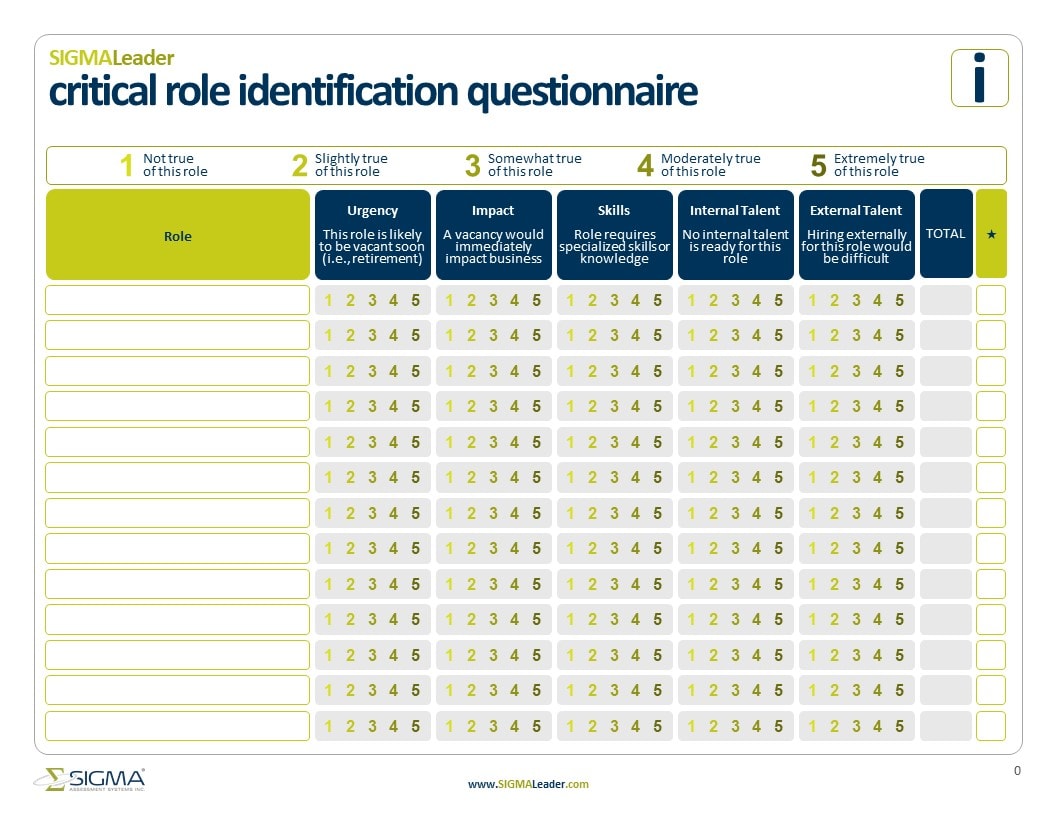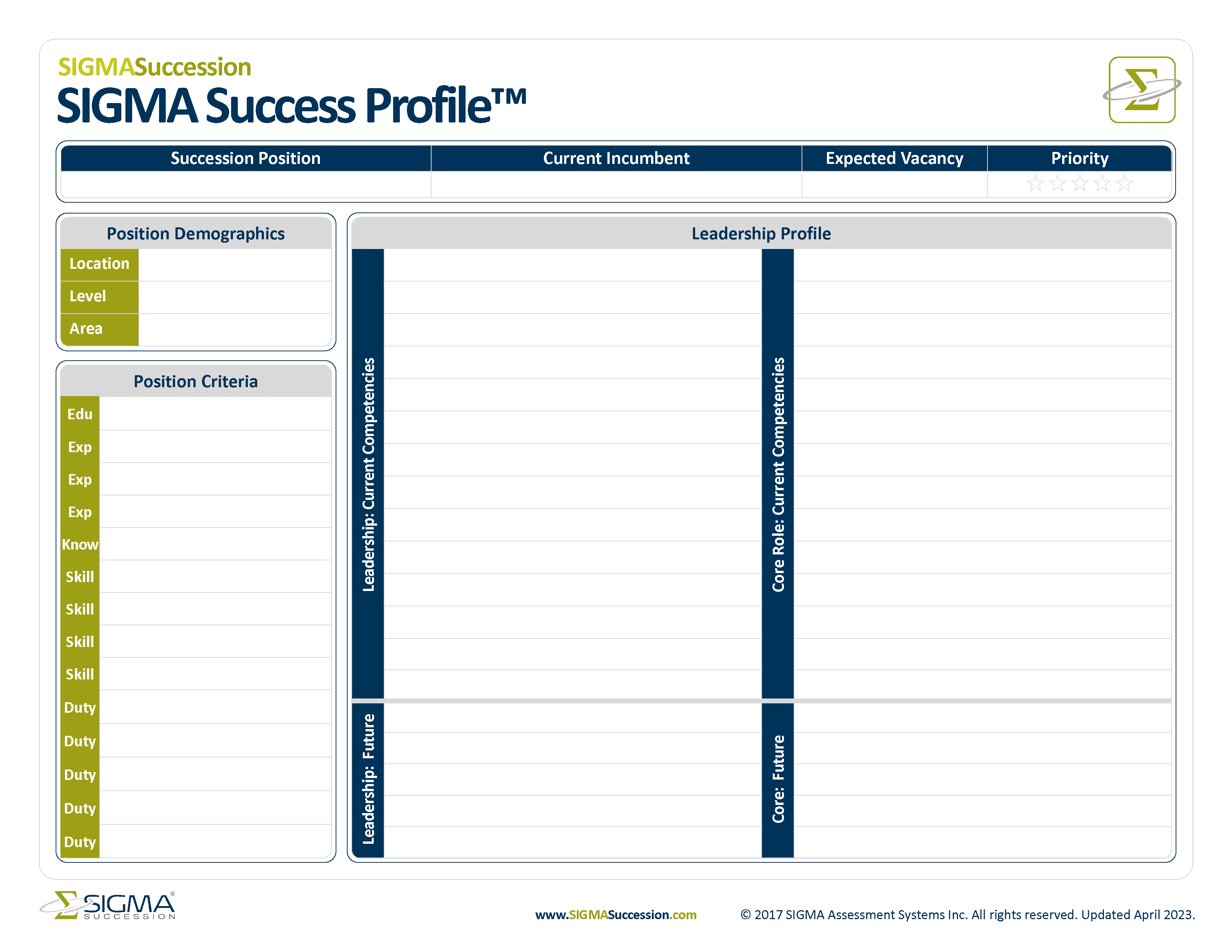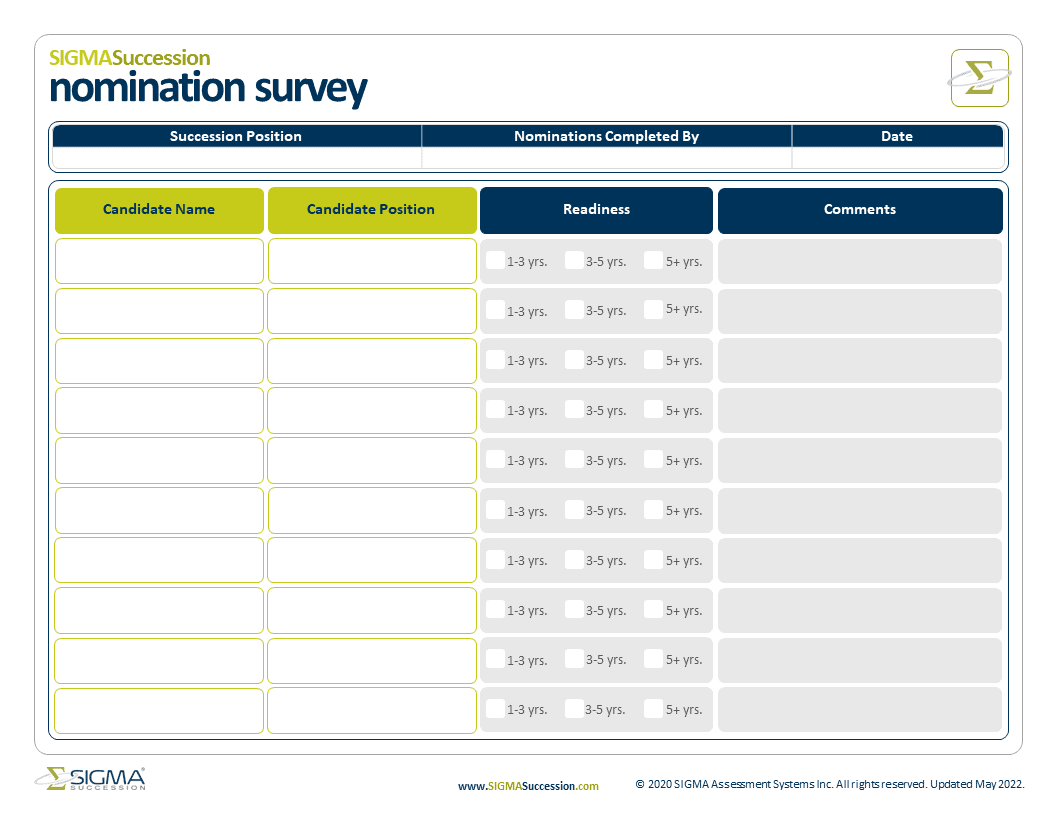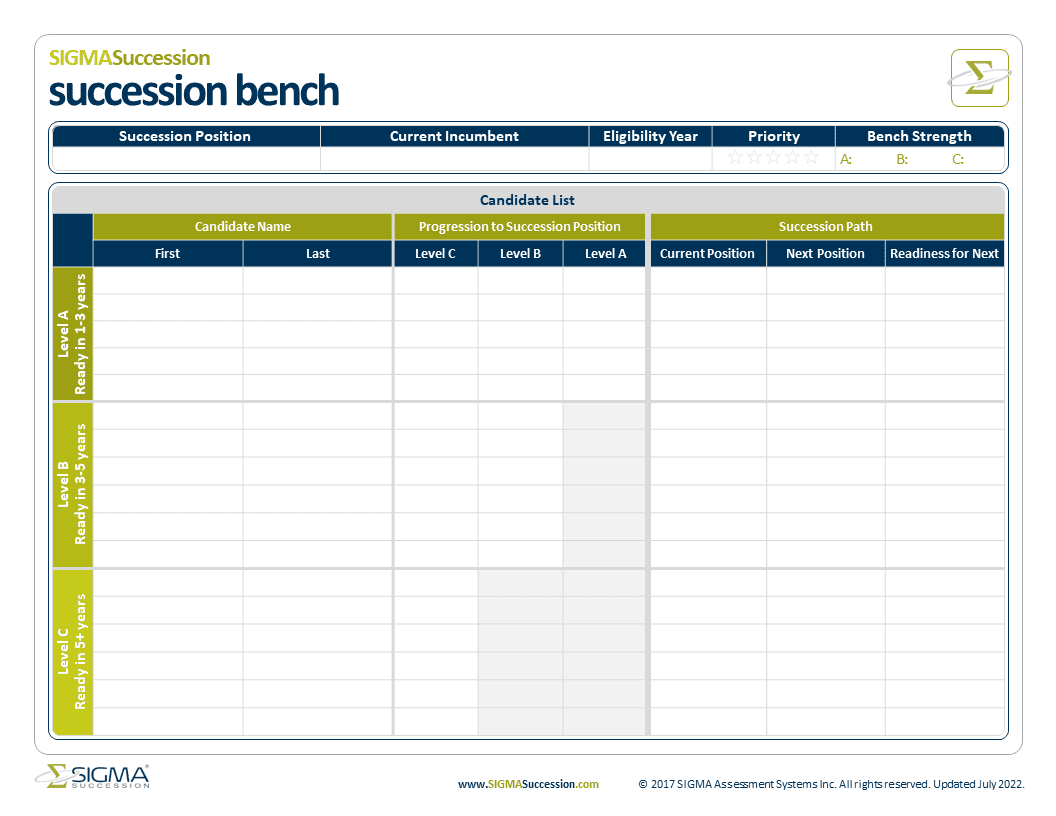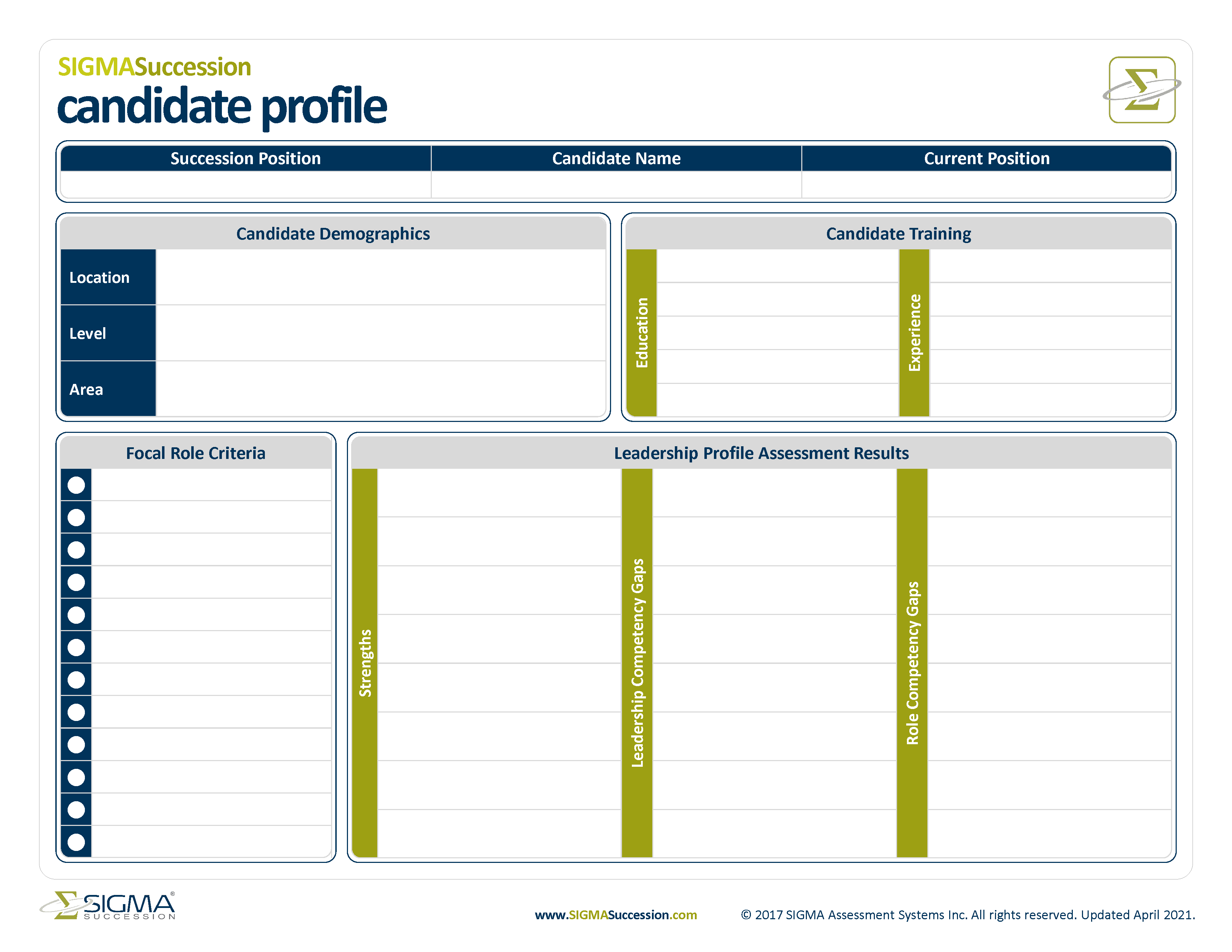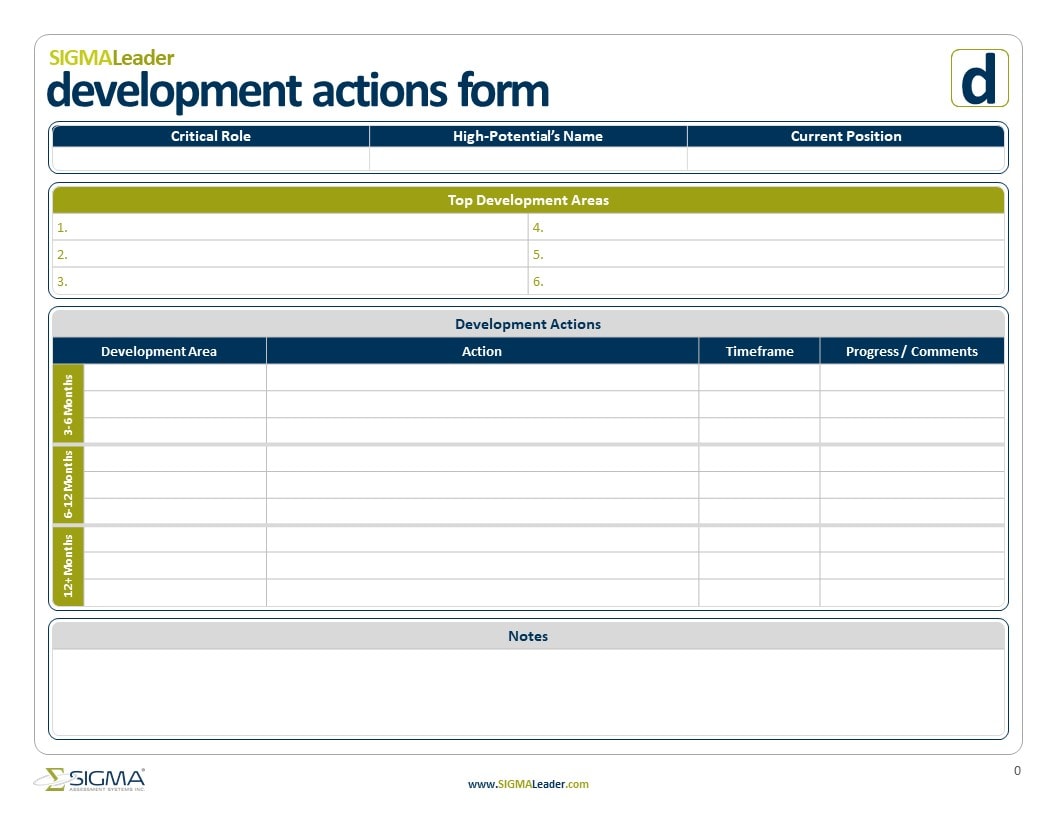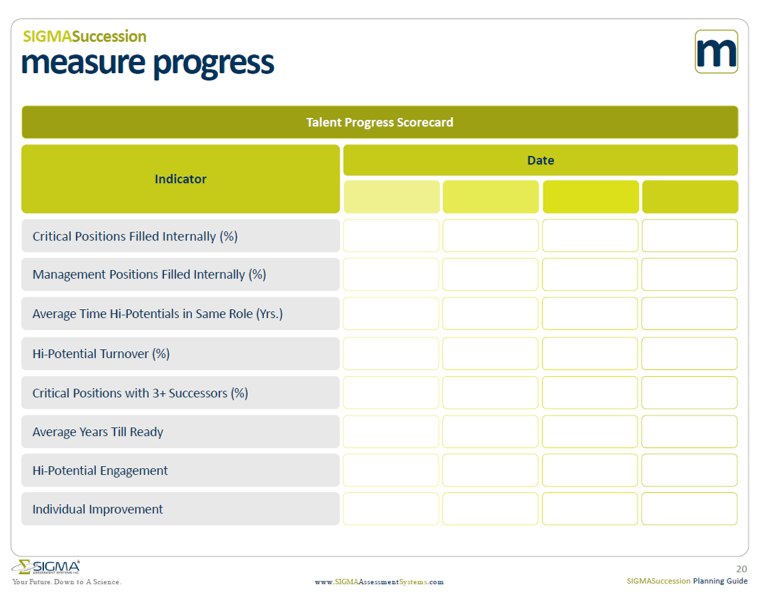6-Step Succession Planning Process
SIGMA’s 6-Step Succession Planning Process
The succession planning process is dynamic — as organizational needs change, the succession plan must evolve as well. It is important to consider how employee aspirations and talents can be aligned with the internal and external environment of the organization.1 Robust succession management provides a roadmap for success, ensuring the necessary structure to support effective, efficient, and consistent communication and implementation throughout all levels of the organization.
Explore SIGMA’s 6-Step Succession Planning Process with this comprehensive overview, featuring essential tools and templates. Each step provides an in-depth explanation and links to download free resources. Access the full overview below:
Why Plan for Succession?
Most organizations recognize the importance of succession planning, yet more than one-third lack a plan — an oversight that can be costly. A recent study by Harvard Business Review (HBR) found that the S&P 1500 collectively forgoes close to $1 trillion in market value each year due to poorly managed CEO and C-suite transitions. According to HBR, effective succession planning could boost company valuations and investor returns by 20-25% per year. Unplanned transitions often push companies to hire externally, missing the benefits of a well-prepared internal talent pool and leadership pipeline. SIGMA has worked with more than 8,500 organizations across North America, and CEOs consistently share that they struggle to plan for the future amidst today’s demands. Recognizing the time and effort succession planning requires, we’ve developed a practical, easy-to-use guide that leads organizations through every stage of our proven succession planning process.
Download SIGMA’s Succession Planning Guide and begin creating your succession plan today.
SIGMA’s Succession Planning Process
SIGMA follows a six-step succession planning process, with each step featuring dedicated tools and templates. This straightforward outline will guide you in using SIGMA’s six-step approach to build a succession plan tailored to your organization.
For detailed instructions and links to download SIGMA’s form-fillable PDF templates, explore the drop-down menus below.:

There is no shortage of leadership roles that can benefit from well-executed talent assessment. However, succession planning requires a thoughtful, strategic approach, especially when implementing it for the first time. The first step in the succession planning process is to pinpoint key roles that should be prioritized based on their urgency and importance to business operations — these are known as “Critical Roles.” To identify which roles are essential for succession planning in your organization, try using SIGMA’s Critical Role Identification Questionnaire below.
TOOLS/TEMPLATES: Critical Role Identification Questionnaire
GET STARTED: Identify Your Organization’s Critical Roles

Once you’ve identified the most critical positions, the next step is to understand the specific requirements of each role. Success profiles are documents that outline the skills and capabilities essential for success in a given position. While similar to job descriptions, success profiles provide additional details, including position demographics (location, level, direct reports) and role requirements (education, skills, and key responsibilities). They also go beyond traditional job descriptions by including leadership competencies that are essential for success now and in the future.
Use SIGMA’s Success Profile™ template to organize these insights, and consider using validated leadership assessments, such as SIGMA’s Leadership Skills Profile – Revised™ (LSP-R), to obtain objective data on key positions and current incumbents.
TOOLS/TEMPLATES: SIGMA Success Profile™, Leadership Skills Profile – Revised (LSP-R)
GET STARTED: Build Strong Success Profiles

Once you have developed an understanding of which competencies are important for success in a critical position, you can begin to nominate potential succession candidates for that position. Start the process by using SIGMA’s Succession Candidate Nomination Survey to help your succession advisory team evaluate the potential of each candidate. Results from the nomination survey are used to populate a Succession Bench that groups successors based on their readiness for the critical role and provides an “eye-test” measure of bench strength for the incumbent’s position. A well-maintained Succession Bench is a great way to measure the success of your overall succession plan.
To complete the Nomination Survey, begin by listing the succession position and entering your name as the person completing the nominations. Be sure to date your entry. Next, list potential succession candidates and their current positions. For each candidate, provide an estimated timeline indicating when they may be ready to step into the succession role. These estimates should incorporate input from various sources, such as current incumbents, senior management, succession advisory teams, as well as the candidate’s leaders, peers, and direct reports. To add context to your evaluation, note any additional information about the candidate’s skills and ratings. Ensure that the Succession Nomination Survey is completed for each succession candidate.
After completing the survey for each critical role, use the Succession Bench Template to identify and organize the top candidates for each key position in your organization. To complete this template, start by noting the incumbent and urgency details for the role, then categorize succession candidates by readiness level:
- Level A: Succession candidates ready for role in less than three years
- Level B: Succession candidates ready for role in 3-5 years
- Level C: Potential successors ready for role in more than five years
Include each candidate’s name and demographics, and track their progress over time. The Succession Bench Template enables you to assess the overall strength of your succession pipeline while monitoring each candidate’s development as they work toward becoming fully qualified for their target roles.
TOOLS/TEMPLATES: Nomination Survey, Succession Bench
GET STARTED: Nominate Succession Candidates

The Nomination Survey is just the beginning of evaluating your bench strength. At this stage of the succession planning process, there’s a valuable opportunity to add objectivity through scientifically validated leadership assessments. While talent assessments don’t replace a review of a succession candidate’s experience and track record, they provide an objective lens for understanding the candidate’s strengths and development needs. Every succession plan should incorporate scientifically validated assessments to gain a clearer picture of each candidate’s readiness for future roles.
To assess your candidates’ development needs, complete the Candidate Profile Template. This template allows you to capture essential information on target positions and document succession candidate demographics, education, and experience. Refer to your Success Profiles for role criteria, and use validated assessments, such as SIGMA’s LSP-R, to evaluate candidates based on the qualities required for the target role. Record any notable gaps between a candidate’s current skills and those needed for the position, then use this worksheet to prioritize growth areas and identify key talent development opportunities.
TOOLS/TEMPLATES: Candidate Profile, Leadership Skills Profile – Revised, MEIA-W-R

After assessing talent and identifying development needs, the next step is to establish a development plan. Crafting individualized development plans is at the core of effective succession planning, helping succession candidates bridge gaps in skills or experience and advance in their readiness for future roles within the organization. To streamline this process, SIGMA offers a Development Actions Form, which helps identify talent gaps and track the progress of succession candidates over time.
SIGMA recommends creating development plans for, at minimum, all high-potential succession candidates, and ideally, for everyone on your Succession Bench.
To complete the Development Actions Form, start by providing information on the candidate’s current role and the critical position they may fill in the future. Then, identify the top development areas from the Candidate Profile, ranking each based on two criteria:
- The largest gaps between role requirements and the candidate’s current abilities
- The most essential or frequently used skills required for the role
Collaborate with the succession candidate to complete their Development Actions Form, selecting focus areas for short-, medium-, and long-term development. After identifying key areas, choose specific development activities, ensuring they are relevant and accessible. Work closely with each candidate to select a variety of activities that provide comprehensive training, and use the form to monitor progress and completion.
TOOLS/TEMPLATES: Development Actions Form, Executive Coaching

Measuring success is a crucial, yet often overlooked, element of every succession plan, as it enables year-over-year tracking and communication of progress. Regularly monitoring measurable progress indicators and sharing results with key stakeholders highlights the value of your succession plan and keeps its importance front and center.
Begin by identifying metrics that can be readily tracked within your organization. Record baseline numbers when beginning the succession planning process and review them periodically. Set a calendar reminder to evaluate, compare, and report on the plan’s progress every six months. Even if you track only one metric, consistently record it, assign a dollar value if possible, and communicate the results to stakeholders.
Use the Talent Progress Scorecard to review the outcomes of your succession program across a variety of indicators, including cost savings, delays prevented, and improvements in HR processes. These indicators will help you effectively communicate the success of the program to senior leadership, succession candidates, and the broader organization
Need a Succession Plan?
If your organization needs an effective succession plan fast, SIGMA’s Succession Planning Sprint is the ideal solution. In just one high-impact, four-hour executive strategy session, our consultants work closely with your leaders to create a customized 12-month succession plan for each member of your leadership team — delivered in only 30 days. For more information, complete the form below and one of our consultants will contact you shortly.
Ready to Get Started?
HOW CAN WE HELP?



Related Blogs
- Clutterbuck, D., & Goldsmith, M. (2012). The talent wave: Why succession planning fails and what to do about it. Philadelphia, PA: Kogan Page Limited. ↩︎


